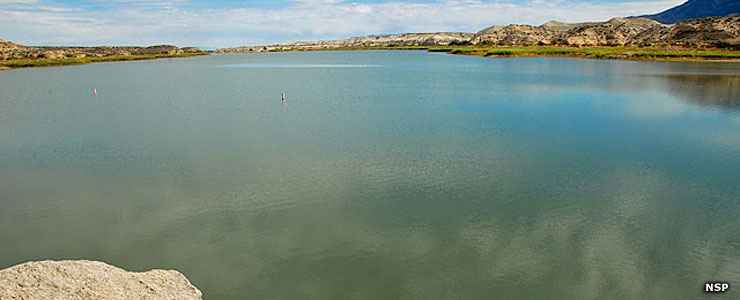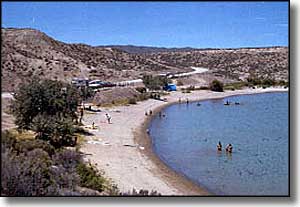Rye Patch State Recreation Area

Rye Patch State Recreation Area at Rye Patch Reservoir
- Camping
- RV Dump Station
- Flush Restrooms
- Group Camping
- Showers
- Picnicking
- Group Picnicking
- Visitor Center
- Boat Launching
- Trails
- Nature Study
- Swimming
- Fishing
- Fish Cleaning Station
- Max. RV size: 45'
- Pets allowed
When the Humboldt River flows enough to keep it full, Rye Patch Reservoir covers some 11,000 acres, offering about 72 miles of shoreline. The State Recreation Area surrounds the reservoir and offers boating, water skiing, fishing, picnicking and camping (the fishing is best in spring and early summer but the catfish are best in the fall).
Thousands of years ago, this area was mostly covered by Lake Lahontan, a large lake fed by the meltwaters of glaciers during the last Ice Age. Depending on the climate, the water level of Lake Lahontan varied widely. About 23,000 years ago, that lake was lower than Rye Patch is today and there were springs flowing upstream of where the reservoir is now. Evidence has been found at some of those spring sites that indicate camels, elephants, horses and bison were common to the area. The first evidence of humans in the area dates back to about 8,000 years ago - in the vicinity of Lovelock Cave.
As time passed, the local climate got hotter and drier. The majority of Lake Lahontan became confined to what are now the Carson and Humboldt Sinks. As today, the Humboldt River flowed mostly in the spring and early summer, carry snowmelt from the mountains downhill to disappear in the sands at Humboldt Sink. Native people gathered in settlements of 25 to 50 along the sides of the river when it flowed, then roamed the desert in smaller groups when it didn't. The first white man to visit the area was probably Peter Skene Ogden in 1829. He came to trap beaver and others soon followed. Then the fur market collapsed and the area only saw the occasional prospector until gold was found in small veins at Rochester, Unionville and Star City. The town of Rye Patch grew up when a stamp mill was built beside the river in 1864 to process the ore from surrounding mines. The town was supposedly named for a patch of rye grass... and quickly had a psot office, school and boarding house. Then the Central Pacific Railroad came through and built a station house in 1869. Rye Patch prospered until the ore ran out and the stamp mill shut down in 1877.

The 75-foot high Rye Patch Dam was built in 1935-6. The reservoir can store up to 200,000 acre-feet of water and can irrigate up to 38,000 acres of farm land. Rye Patch Reservoir was transferred from Pershing County Water Conservation District and Parks Department to Nevada State Parks and became a State Recreation Area in 1971.
Rye Patch State Recreation Area offers 3 picnic/day use areas, each with tables, campfire grills and restrooms nearby. There is a campground along the river below the dam that offers tables, restrooms and showers but no hookups. There is another campground (25 sites) on the west side of the reservoir that also offers tables, restrooms and showers but no hookups. Camping is first come, first served. There are also many undeveloped campsites around the reservoir that can be reached by boat or by various primitive roads. Camping in these undeveloped sites is allowed unless otherwise posted.

Map courtesy of National Geographic Topo!